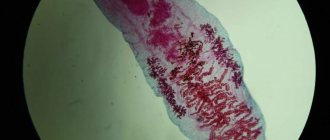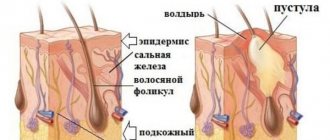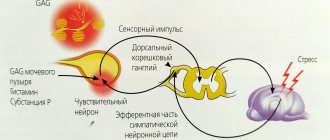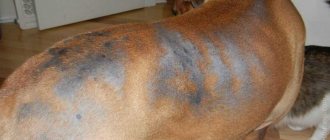How does sarcoptic mange manifest?
The infection is asymptomatic - this is the period while the tick, after entering a new organism, becomes accustomed and gradually begins its life activity. The incubation period, when there are no outward signs of the disease, takes from 10 to 14 days.
Then sarcoptic mange in dogs acquires the following symptoms:
- itching appears, which does not stop throughout the course of the disease. There is some weakening of it in cold weather and an increase in hot weather, when the air is dry;
- Individual foci of rash begin to form;
- nodules form, then bubbles with transparent contents, which burst and scales and dry crusts appear. As the disease progresses, there are more and more such places;
- in some places the hair falls out, areas of baldness (alopecia) form;
- in areas of prolonged scratching, the skin may thicken and become keratinized;
- dandruff appears over the entire surface of the body due to flaking of the skin;
- a pedal-ear symptom is noted when the dog tries to scratch the outer surface of the ear with its hind paw;
- if bacteria join the main process, then suppuration of the skin may begin, giving the dog a very unpleasant odor.
Rashes usually appear in those parts of the body where there is the least hair:
- muzzle, brow ridges, ears;
- stomach and groin;
- armpits;
- paws at the elbows and hocks.
As the disease progresses, the dog becomes increasingly irritated by constant itching, followed by deep depression and loss of appetite. In some cases, body temperature may increase. Lymph nodes may become inflamed due to general intoxication of the body. Ultimately, the animal faces exhaustion.
The most important thing to do is to isolate the sick dog from healthy pets. Treatment of the disease is complex and includes not only injections of anti-tick drugs, but also local treatments. Only a veterinarian decides how to specifically treat sarcoptic mange in a dog, based on each individual case. The course of treatment depends on the degree of neglect of the disease.
If local treatments are required, the affected areas should be well trimmed to ensure more thorough contact of the drug with the skin.
Treatment for sarcoptic mange includes the following medications:
Diagnosis and treatment
The diagnosis is made on the basis of medical history, clinical examination and detection of the pathogen by microscopy of skin scrapings. The difficulty of detecting mites in scrapings often leads to false negative results, therefore, in the presence of a characteristic clinical picture, it is advisable to carry out trial therapy, that is, treating the animal with antiparasitic drugs that act on mites for diagnostic and therapeutic purposes.
Treatment of pruritic scabies (sarcoptic mange) in dogs in the early stages is easy due to the availability of safe and effective acaricidal drugs on the market. Currently, veterinarians recommend drugs from the groups of macrocyclic lactones or isoxazolines to treat dogs with pruritic scabies. One of the drugs active against sarcoptic mange is Stronghold. The drug is applied to intact dry skin at the base of the neck in a dose corresponding to the instructions for the weight of the animal. To treat dogs with pruritic scabies, treatment with Stronghold is carried out twice with an interval of a month. The drug is quickly absorbed from the skin, bathing with shampoo does not reduce its effectiveness, therefore, if necessary, the animal can be bathed with shampoo within two hours after applying Stronghold. The drug is not recommended for use if the dog has increased individual sensitivity to Stronghold, puppies under 6 weeks of age. Treatment of pregnant and lactating females with Stronghold is permitted, but it is recommended that it be carried out under the supervision of a veterinarian.
Another drug active against sarcoptic mange is Simparica, available in tablet form. The drug is quickly absorbed from the gastrointestinal tract and is low-hazard in terms of the degree of impact on the dog's body, however, Simparika should not be used in cases of increased individual sensitivity to the components of the drug, puppies under 8 weeks of age, as well as dogs with severely impaired kidney and liver function and patients infectious diseases. As a rule, dogs voluntarily eat the tablet, since it has a liver taste that is attractive to the dog; eating the food does not affect the absorption of the drug. To treat sarcoptic mange, Simparicum is given twice with an interval of 30 days.
To eliminate secondary bacterial infections, in addition to antiparasitic treatment, dogs can be bathed with medicated shampoos containing 4% chlorhexidine or benzoyl peroxide, according to the instructions.
In the later stages of the disease, when deep skin infection and intoxication develop, an integrated approach to treatment is required, including antibiotics and antitoxic therapy in a clinical setting.
A characteristic feature of this disease is a possible increase in itching during the first few days after treatment with antiparasitic drugs, regardless of the form of the drug (tablets or drops on the withers), so Apoquel tablets can be used to alleviate the condition and reduce itching in adult dogs. The drug is prescribed orally at a dose of 0.4 - 0.6 mg/kg twice a day, regardless of feeding, for several days, as long as there is itching. Apoquel is not recommended to be given to puppies under one year of age, male dogs during the mating period, pregnant and lactating females, as well as dogs with progressive malignant tumors. Without consultation with a veterinarian, Apoquel can be used twice a day for no longer than 2 weeks, then it is acceptable to take the drug once a day. The drug is a low-hazard substance, is not a hormone and is not a cytostatic, however, persistence of itching for more than two weeks after antiparasitic treatment is not typical for sarcoptic mange and requires additional diagnostics.
Symptoms and signs of mange in dogs. Recognize the disease and start treatment as soon as possible
After the itching gets on your pet’s skin, the first symptoms of the disease begin to appear after 1-2 weeks. The disease has the following symptoms:
- At the first stage of the disease, redness is observed in the area of the skin affected by the mite. Most often, the dog's head and neck are affected first;
- Next, pinpoint rashes of small bubbles filled with liquid are noticeable. When combing, the bubbles burst. Such areas of the skin are very flaky and seem to be sprinkled with bran;
- At the last stage of pruritic scabies, if left untreated, the dog’s body becomes depleted.
The main signs of scabies in dogs, which the owner can notice with the naked eye, are:
- Itching, worse at night, which constantly bothers the animal;
- The fur becomes dull, looks disheveled, and falls out in clumps;
- Peeling and crusting are observed on bald areas of the skin.
Causes and methods of infection
The cause of the disease is contact with a sick animal. Moreover, you can become infected not only by touching or petting a sick dog, you can “catch” a tick through the belongings or household items of an infected animal.
Ticks can also be found in parks, dog groomers or kennels for you or your pet, but the risk of infection this way is quite low, so you should not avoid these places. The only scary thing is that you can find out about the disease only after 2-3 weeks from the moment of infection; before that, the tick practically does not manifest itself at all.
How is scabies treated in dogs?
Only a veterinarian at the clinic can diagnose and prescribe treatment for sarcoptic mange for your pet. When making a diagnosis, the specialist takes into account the clinical symptoms of scabies in the dog and the results of examining deep skin scrapings under a microscope.
After pruritic scabies in dogs is established, the animal is prescribed medicinal treatment for the underlying disease and accompanying symptoms, and feeding is adjusted.
Pathogen
Sarcoptosis is not an independent pathology of the body; it is provoked by mites Sarcoptes Canis , which choose not only dogs as their habitat, but also other domestic and wild animals and even humans. Sarcoptic mange mites are widespread in Europe, especially in its eastern part. These mites parasitize both on the surface of the skin and in its inner layers, feeding on lymph, serous exudate and dead cells.
Sarcoptes Canis
These mites are very small, the length does not exceed half a millimeter, the body is oval with scales on the back, they do not have eyes, they feed thanks to the proboscis. Once on the fur or skin of an animal, the female mite begins to bite into the skin and lay eggs there.
During a life period that lasts only fifteen days, the female can lay up to 50 eggs . As a rule, they live on the dog's face, ears, chest and back. The disease in puppies up to six months is more severe than in adult dogs, since the immunity of puppies is not yet strong enough.
Pruritic scabies in dogs: a dangerous disease is easier to prevent than to treat
To prevent the animal from contracting a dangerous disease, experienced breeders and dog owners use the drug BlochNet max in the form of drops on the withers to treat the dog. Veterinarians also recommend regularly treating the dog’s bedding and the room where it is kept using BlochNet spray. This will help protect you and your pet as much as possible from scabies mites.
- BlochNet max protects the animal for a long time. After treating the dog with drops, protection lasts up to 2 months
- The drug is available in the form of drops on the withers - this is the most convenient form for treating scabies in dogs
- BlochNet max is completely safe for animals. It does not have a skin irritant or toxic effect.
Prevention
Preventive actions:
- Treating your dog's belongings after a walk with anti-parasite medications.
- A ban on dogs playing with stray animals. If contact occurs, treatment is carried out with a solution of 2 percent chlorophos.
- Wearing an anti-parasite collar. The device does not act on ticks.
- Undergoing a routine examination by a veterinarian. Produced once every 6 months.
- Disinfection of the pet's bedding, periodic replacement of the bed.
- Prevention of scabies.
- Washing with shampoos (have acaricidal properties).
Regular examination of your dog is a guarantee of timely detection of various diseases. Activities increase the life expectancy of your pet.
Symptoms
Symptoms of sarcoptic mange do not appear immediately; as a rule, after infection it takes two to six weeks for the first symptoms to appear.
The first manifestations of Sarcoptes Canis mite infestation are the appearance of small papules with liquid inside, in the area of the dog’s nose or ears. These papules cause itching in the dog, so the dog is constantly itching. Scratched papules turn into scabs, and the fluid constantly flowing from the papules causes the fur to stick together. This may also be accompanied by the appearance of dandruff in the dog. If proper treatment is not started after the first papules appear, then sarcoptic mange begins to quickly spread to other parts of the pet’s body.
At the next stage of the disease, the dog begins to lose hair in the affected areas , scabs also appear on them, in advanced cases bleeding and cracks may occur, and a sour smell emanates from the animal. If the room is very hot, this increases the animal’s scabies; in a cool room, the dog itches less. During this period, dogs become lethargic and apathetic, and lose their appetite.
Sometimes dogs may experience cuts on their hind legs. If the symptoms are not paid due attention, they can become chronic, which will be accompanied by an increase in the size of the lymph nodes, lichenification, severe skin pigmentation, and at this stage the death of the dog may even occur.










